Done for 2009: The Holiday MacBook Pro Roundup
by Anand Lal Shimpi on November 10, 2009 12:00 AM EST- Posted in
- Mac
Performance
Benchmarking under OS X is a bit of a pain. There aren't many good standardized real world benchmarks, and unfortunately the synthetic tests are often over used.
General OS usage is a difficult thing to quantify, but one measure of performance has always been the number of bounces an icon in the dock makes before an application loads. I decided to take it to the next level and write a quick script to launch 15 applications in a row, timing how long the entire process takes.
I launched, in order: Mail, Safari, Activity Monitor, iTunes, iCal, DVD Player, iPhoto, Photo Booth, Quicktime Player, Disk Utility, Preview, iMovie, Front Row, Garage Band and Aperture.
The entire process stresses both the disk and CPU, which is why we see a huge improvement when going to an SSD as well as differences between CPU speeds.
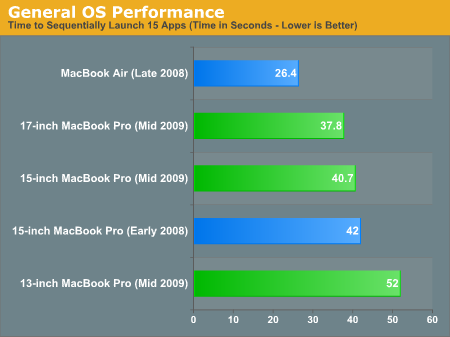
The 13-inch MacBook Pro performs the worst here by a large margin, not just because of its lowly 2.26GHz Core 2 Duo, but also because it only has 2GB of memory. The 13-inch system takes nearly 30% longer to load all of the apps because of its limited amount of memory.
The 15-inch MacBook Pro uses a 2.53GHz Core 2 Duo instead of the 2.80GHz chip in the 17-inch by default. The result is a 7% longer load time on the 15-inch system, not huge, but not insignificant. As always, I recommend getting the fastest CPU you can afford if you're planning on keeping this machine for a while.
The fastest machine here is actually the MacBook Air, because it comes with an SSD. Your best bet to improve overall system responsiveness and launch times is to get a good SSD. Even with only 2GB of memory, the current gen MacBook Air finishes the script faster than the 17-inch MacBook Pro. Paired with an Intel X25-M G2 the 15-inch MacBook Pro can run through our script in 16 seconds.
Adobe Photoshop CS4 Performance
The Retouch Artists Speed Test we use for our CPU testing under Windows also works under OS X. We're running the exact same benchmark here, basically performing a bunch of image manipulations and filters and timing the entire process.
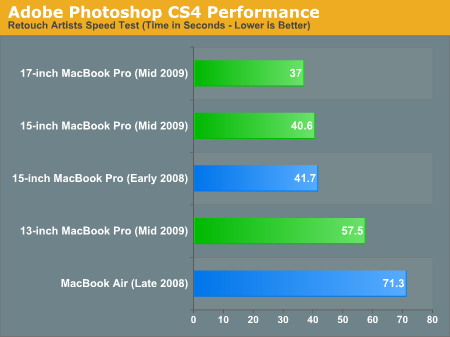
Despite limiting Photoshop to not keeping any history, the 2GB 13-inch MacBook Pro takes around 40% longer to complete the test than the 15-inch MacBook Pro. If you're planning on doing any Photoshop work you'll want to upgrade the 13-inch system to 4GB of memory.
The slower CPU in the 15-inch system penalizes it by around 10% compared to the 17-inch MacBook Pro. For any sort of real performance work, it looks like a 15-inch MacBook Pro with the 2.80GHz upgrade would be a good balance of price/performance.
As I alluded to earlier, there's not much of a performance improvement from the early 2008 MacBook Pro to the current generation. Drive speeds have improved a bit but overall performance hasn't really gone up, it's why Apple had to rely on updated looks and much better battery life to sell systems this time around. Not a bad tradeoff if you ask me, you'll see the performance improvement next year with Arrandale.
Aperture 2 RAW Import
For my Aperture test I simply timed how long it took to import 203 12MP RAW images into the library.
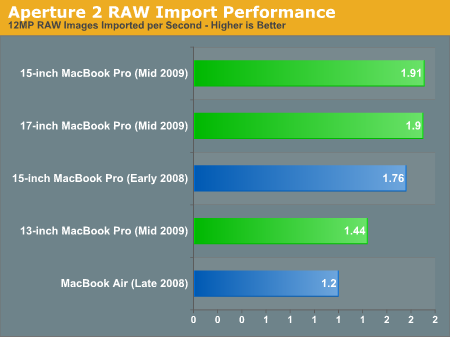
Once again, 2GB isn't enough, the 15-inch and 17-inch are indistinguishable but the 13-inch system takes much longer here.
Cinebench R10
3D rendering performance is mostly CPU bound so the 13-inch system isn't penalized by its memory limitations. Here the 2.53GHz Core 2 Duo is around 11% faster than the 2.26GHz in the 13-inch MBP. The 2.80GHz CPU is another 11% faster on top of that.
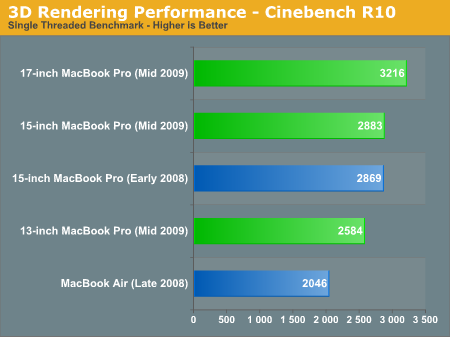
In the multithreaded bench the performance advantages are about the same, a bit closer to 12% between chips.
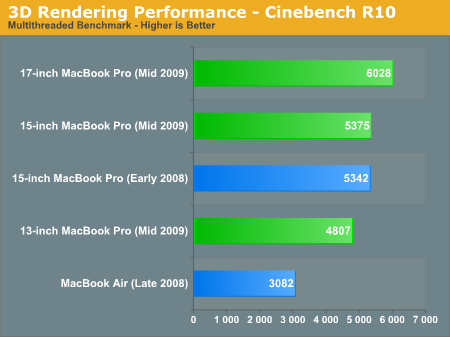
Again we see that CPU speed hasn't really improved much since early 2008, the two 15-inch systems are basically equal performers here.
Quicktime H.264 Video Encoding
Our final benchmark is more consumer focused. Here I'm taking an XviD and converting it to an iPhone-supported H.264 format.
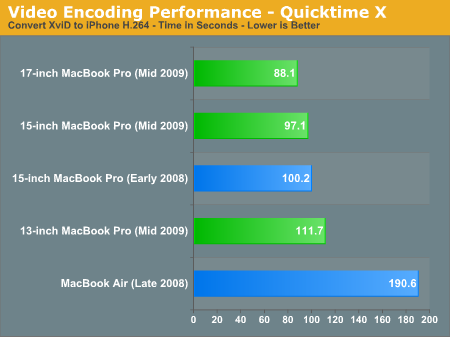
We're CPU bound here so the 13-inch system only takes 14% longer to convert our video clip than the 15-inch. The difference between the 15-inch and 17-inch is about another 10%.










115 Comments
View All Comments
ltcommanderdata - Tuesday, November 10, 2009 - link
I believe Anand did comment on screen resolution on page 4 where he found the 15" resolution just right for the screen between space and not being an eyestrain. Personally, I agree that 1440x900 on a 15" screen is about right. I've found 1680x1050 on a 15" screen to be a bit too dense. Although that just brings up Apple's lack of progress on resolution independence which has been in development since Tiger.On the topic of screens, I wonder what are the chances that Apple will move to 16:9 screens as on the iMac and as other notebook manufacturers are doing. I hope not as 16:10 is wide enough and it's not like watching movies is the only thing people do on their laptops. Besides, for the creative industry users working on 16:9 content, 16:10 screens should make sense to leave room for toolbars and such for editing.
secretanchitman - Tuesday, November 10, 2009 - link
agreed. 1680x1050 on the 15" would be absolutely perfect. i would rather have 16:10 rather than 16:9.i would also love to see core i5/core i7 (doubtful on core i7 though), a much faster gpu (next gen nvidia/ati), and the expresscard slot to make a return as an option. also, most of all, PLEASE make sure the matte screen and silver bezel return!
darwinosx - Tuesday, November 10, 2009 - link
I like the current resolution. Anything higher would be too high for me.ltcommanderdata - Tuesday, November 10, 2009 - link
I don't know exactly how it works, but I've read before that 64-bit Safari is able to use a 32-bit Flash plugin through InterProcess Communications (IPC). Presumably, this causes more overhead and the 32-bit Flash plugin wasn't designed/optimized for this in mind, so that could explain why battery life is so poor under 64-bit Safari with Flash.In terms of Macs, I have to agree that qualities like battery life, weight, look, and feel are things that can be worth paying extra for even if they are harder to definitively measure and compare.
I wonder what Apple is going to do about the IGP situation when they move to Arrandale? It definitely seems strange that nVidia's CEO picks now of all times to advertise his love for Macs after ATI pushed nVidia out for discrete GPUs for the iMacs and on the eve of Arrandale's IGP and DMI link. Presumably Apple could consider using switchable graphics between Arrandale's IGP and discrete GPUs even for low-end models. The effort put into Intel IGP drivers in Snow Leopard bringing the GMA X3100 up from OpenGL 1.2 support in Leopard to OpenGL 2.0 support seems to indicate a readiness of Intel IGPs. It will of course force the introduction of another chip on the motherboard, which is a concern for the space constrained 13" MacBook Pro.
If Intel won't license DMI to nVidia, I wonder if Intel would license it to their good buddy Apple. Apple could then license nVidia graphics technology to serve as the IGP for their own custom chipset. Apple used to design their own chipsets in the PowerPC days and certainly have the resources to do so now with the P.A. Semi team. Besides a better IGP, a custom chipset would also allow Apple to integrate functionality currently done by external chips like Firewire controllers and the multi touch touchpad controller as well as adopt new technologies like USB 3.0 and Lightpeak without waiting on Intel. I believe Jobs did say in a previous conference call their intention to differentiate themselves by offering technology that no one else has and this is certainly one way to do it.
This article seems to mention Arrandale a lot as the future processor of the MacBook Pro, but hopefully Clarksfield will also be available on the 17" and high-end 15" models. Clarksfield clock speeds are disappointing though (1.6GHz - 2GHz) so it'll be interesting to see how Apple plays it.
JarredWalton - Tuesday, November 10, 2009 - link
Clarksfield is a power hog, and there's no getting around that. I've got an i7-720QM based laptop and if I use absolutely minimal performance settings (CPU at 0%, HDD turn off at 1 minute, DVD and webcam turned off when on battery) I barely get 90 minutes of battery life with a 55Wh battery.I can't imagine Apple will ever use Clarksfield in a laptop, because they are targeting mobile battery life far more than mobile performance. Frankly, even the top-end 17" MacBook Pro is pretty weak in many of the performance areas we'd look at on Windows. A 9600M GPU is nothing to write home about -- 32 SPs is what we had back in the days of the GeForce 8600. OS X seems more dependent on CPU, though.
I'm also curious about which CPUs Apple is using; previously they used the SL9000 and SP9000 I'm pretty sure, but now it looks like they're using standard P8000, P9000 and even T9000 parts (though only on the 15" and 17" for the T9000 I'm sure). Maybe Anand can say which specific CPUs are in the Macs now.
ltcommanderdata - Tuesday, November 10, 2009 - link
I didn't know Clarksfield battery life was so bad at idle/light usage. I thought that peak power consumption would be higher, but idle/light power would be comparable or better then high-end mobile Core 2 Duos due to the Power Control Unit. I guess Clarksfield could serve as the real test of Apple's power management abilities. Although with Anand finding that a MacBook Pro gets 78% better battery life in OS X than Windows 7, and a 17" MacBook Pro having a 95Wh battery compared to your 55Wh battery, if you get 90 minutes with the i7-720QM, Apple could get around 4.6hrs in OS X on a 17" MacBook Pro with that processor which is okay. Although Clarksfield would probably be limited to BTO only to avoid confusion.And I agree that Apple's GPU choices are generally questionable, especially seeing OS X's heavy reliance on the GPU starting with Quartz Extreme acceleration in Jaguar in 2002, Core Image in Tiger in 2005, and now OpenCL in Snow Leopard. I guess the only small consolation is that Apple always uses at least GDDR3 with their GPUs, even low end ones like the HD2400XT in the iMac, and doesn't resort to advertising high VRAM capacities and then sneaking in low clock speed DDR2. Hopefully, Apple's notebook refresh jumps directly to DX11 GPUs, presumably ATI since they seem to be first out of the gate. Preferably, they will go with a high mid-range GPU, although I guess heat and power and always Apple's concerns in a 1" case.
darwinosx - Tuesday, November 10, 2009 - link
OS X is not "dependent" on cpu but it can use the cpu for things other than standard vid card work.dagamer34 - Tuesday, November 10, 2009 - link
Clarksfield is a 45W CPU, which Apple will never use due to heat concerns.I'm really hoping that Apple changes the screen to a 16:9 ratio, which would be perfect for watching HD content. Something like: 1366x768 for the 13", 1680x950 for the 15" and 1920x1080 for the 17" would be a great improvement.
kapute - Wednesday, November 11, 2009 - link
16:9 screen ratio is terrible idea for laptops. Ok for watching movies but not when using a word-processor as all the tool bars etc diminish vertical space leaving a tiny letter box to type in. Better to have black bars top and bottom when watching a movie and more vertical space for everything else.ltcommanderdata - Tuesday, November 10, 2009 - link
Well, I'm pretty sure Apple's top end CPUs like the 2.8GHz Core 2 Duo and 3GHz BTO in the high-end 15" and 17" MacBook Pros are 35W TDP processors. The PM55 northbridge has a 7W TDP. It's hard to isolate a comparison to the 9400M chipset since it has both northbridge and southbridge integrated. Still, 35W CPU + ~7W for a northbridge compared to 45W for an integrated CPU + NB in Clarksfield doesn't seem unreasonable, from a heat dissipation perspective.